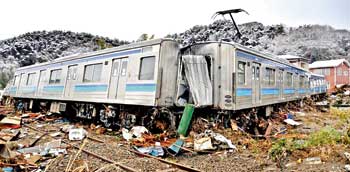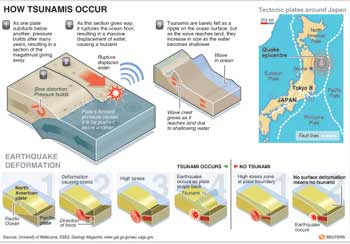MINAMI SOMA, Japan, March 12 (AFP) - The sun rose on scenes of utter devastation in Japan today, after a tsunami triggered by the nation's biggest-ever quake tore away whole towns to leave only mangled debris and broken hearts.
Nothing could stop the terrifying waves that within seconds destroyed buildings and entire streets, reducing what used to be thriving communities into burning piles of shattered wood and rubble.
Paddy fields and farms that had provided livelihoods for many were transformed into saltwater lagoons, the landscape unrecognisable from before the torrents of seawater thundered across the land.
The carriages of a commuter train lay strewn across a broken muddy landscape in Fukushima, one of the areas worst hit by the tsunami.
 |
| The wreckage of a train destroyed by Friday’s earthquake and tsunami is seen near the coastal town of Sendai. REUTERS |
Survivors looked for missing loved ones in the hardest hit areas such as Miyagi or Iwate prefectures.
“There are so many people who lost their lives,” an elderly man told TV reporters before breaking down in tears. “I have no words to say.”On Saturday repeated aftershocks struck fear of yet more deadly waves as the scale of the horror kept unfolding. In northeastern Minami Soma, 1,800 houses were damaged or destroyed, an AFP reporter said.
“A tsunami can occur over and over again. Even if waves appear to have receded, people must not forget that the waves can return again in force,” said Hirofumi Yokoyama, a quake official at the Japan Meteorological Agency.
He urged residents who have fled their homes not to return yet. But those whose houses were still standing were the lucky ones.
Authorities said more than 3,000 homes were destroyed or swept away.
The tsunami left Rikuzentakata, a coastal city of some 23,000 people, “almost in shambles,” the national Fire and Disaster Management Agency said.
Tens of thousands of people evacuated from areas near two nuclear plants as authorities scrambled to avert a potential atomic meltdown after five reactors threatened to overheat and emit harmful levels of radiation.
Scores of fires still burned but an oil refinery near Tokyo that had been set ablaze in the immediate aftermath of the quake now only smouldered, its raging fires finally tamed.
Cars were dumped on top of flattened houses and large ships were run aground into what used to be urban areas, but it was difficult to tell where the towns or streets used to be in places such as Miyagi Prefecture that were hammered by the waves.
Pockets of smoke billowed up into the sky from landscapes laid bare by the fury of nature. Several hundred burning cars at a pier at Hitachi Port in Ibaraki billowed smoke into the morning's seemingly cruel sunshine.
Is the quake the latest natural disaster to have been caused by a 'supermoon'?
The powerful tsunami that slammed into Japan's eastern coast on Friday came just two days after warnings that the movement of the moon could trigger unpredictable events on Earth.
Astrologers predicted that on March 19 -- six days from tomorrow -- the so-called 'supermoon' will be closer to Earth than at any time since 1992, just 221,567 miles away, and that its gravitational pull will bring chaos to Earth.
Others on the Internet have predicted it will cause further catastrophes such as volcanic eruptions and earthquakes.
Coming just three weeks after the quake which devastated Christchurch in New Zealand killing hundreds, this latest disaster will only add fuel to their fire.
However the 'supermoon' date is still seven days away. But those that adhere to this particular belief could claim that this was still close enough for there to be some kind of effect.
On Wednesday, in an interview with ABC radio discussing the potential impact of the March 19 supermoon, astrologer Richard Nolle, who first coined the term in 1979, said he was convinced that lunar perigees cause natural disasters on Earth.
'Supermoons have a historical association with strong storms, very high tides, extreme tides and also earthquakes,' he said.
However, scientists dismiss this as utter nonsense and that although it makes a good photo opportunity for astronomers it has no impact on Earth.
Dr David Harland, space historian and author, said: 'It's possible that the moon may be a kilometre or two closer to Earth than normal at a perigee, but it's an utterly insignificant event.'
Professor George Helffrich, a seismologist at the University of Bristol was equally dismissive.
'Complete nonsense. The moon has no significant effect on earthquake triggering.
'If the moon triggers "big" earthquakes, it would trigger the many of millions of times more "small" earthquakes that happen daily. There is no time dependence of those; hence no moon effect.'
The moon's orbit around Earth is not a circle, but an ellipse. At its closest approach -- the perigee -- the moon appears brighter and larger in the sky. When it is furthest away -- the apogee -- it is smaller and dimmer.
A lunar perigee occurs once a month. However, next week's perigee coincides with a full moon - a combination of events that happen just once every two or three years.
© Daily Mail, London
How awesome po wer of tsunami is un-leashed
By Michael Hanlon
The total energy released by Friday's quake is equivalent to the explosion of 6.7trillion tons of TNT, about a thousand times the combined power of all the world's nuclear weapons.
And the scenes we have seen are a reminder of the fact that earthquakes under the sea can be so much more deadly than those which happen on land.
Like the New Zealand quake, like last year's devastating magnitude-8.8 earthquake in Chile which killed several hundred, and the tsunami on Boxing Day in 2004 which killed more than 250,000, Friday's catastrophe was a result of the titanic geological forces operating around the Pacific 'Ring of Fire'.
This is a 25,000-mile belt of earthquakes and volcanoes encircling the great Pacific Ocean, a chain of giant fault lines which separate some of the largest of the Earth's tectonic plates - the dozen-or-so slabs of solid rock which make up our planet's crust.
The Ring of Fire runs from the Arctic in the north along Russia's east coast, down past Japan, south to Australia and New Zealand, across the ocean to the west coast of South America and then up to North America.
The plates themselves consist of sheets of basalt and granite between five and 30 miles thick, underpinning both the continents and the ocean floors. They float on the viscous, semi-molten rocks beneath the crust and are able to move, typically a few inches a year, propelled by currents deep in the mantle - the part of the Earth below the crust.
Where plates meet they may be pushed apart, allowing the molten lava to well up from below. The volcanoes of Iceland, for example, are formed in this way. But where plates collide or grind against one another, even more unimaginable forces are generated as the crust buckles and deforms under the strain. This is what is happening around the margins of the Pacific.
Great earthquakes are wholly random, unpredictable and usually unrelated (there is no link, for instance, between the New Zealand earthquake and this one) although a huge quake like this will generate dozens or hundreds of aftershocks which would normally be regarded as serious earthquakes in their own right.
And the truth is that absolutely nothing can be done to prevent them - the forces are larger than anything humanity can tame.
Friday's earthquake occurred where the dense oceanic crust of the Pacific Tectonic Plate is slowly being forced under the North American Plate by a process called 'subduction'.
In this case the two plates are overlapping, with movement occurring along a 'thrust fault' - a huge crack in the Earth's crust, running at an angle along the plate boundary where the overlap occurs.
Most of the time, plate movements like this are gradual, smooth and steady; a slow undramatic grind of a few inches a year at most, the energies this creates dissipated by gentle microquakes and volcanic activity. But sometimes something 'catches', preventing further movement until huge strains build up.
When the pent-up stress becomes too high, the two huge slabs of rock can suddenly jolt tens of feet in less than a second, generating a shock wave which on land is felt as an earthquake and which under the sea causes a massive displacement of water. This in turn, causes the tsunami, a Japanese word which means 'Harbour Wave'.
Tsunamis (often erroneously called 'tidal waves') may be caused by landslides, underwater volcanoes, meteor impacts or even nuclear tests but the most destructive by far are those generated by underwater earthquakes - especially those occurring along substantial 'linear faults' such as that Friday off the coast of Japan.
The focus, or 'hypocentre' of this quake - which is where the sudden movement took place between the two overlapping tectonic plates - was about 17 miles beneath the ocean floor. It is here that the maximum amount of energy was released, generating a huge pulse of energy in the water above the seabed.
Big earthquakes on their own typically kill hundreds, but tsunamis can kill hundreds of thousands - showing that the power of angry water has perhaps the greatest potential to wreak death and destruction of any natural phenomenon.
In deep water, even the greatest tsunami may be almost unnoticeable - a disturbance of just a few inches perhaps, but travelling at hundreds of miles an hour across the ocean surface. It can cross a whole ocean with ease, yet when the tsunami hits shallow water near the coast, the tiny wave slows down and swells into a monster, a wall of water tens or even hundreds of feet high which can hammer inland at 50mph. On Friday, the United States Geological Survey announced that, although hundreds have died, the actual shaking caused by the earthquake was expected to generate very few casualties.
Professor Ian Main, a geologist at the University of Edinburgh, said that this was thanks to 'a combination of effective earthquake-resistant building codes and the relatively remote location of the earthquake off shore'.
Of all the countries in the world it could strike, Japan is one of the very best prepared.
It is not only a very rich country; it is also the most earthquake-aware nation on Earth. Schoolchildren undertake regular 'earthquake drills' and building standards are the strictest in the world.
Modern buildings are designed to move with the Earth, their components linked by flexible bearings - similar to shock absorbers in cars - which can dissipate the shock.
On Friday, the Japanese authorities issued a rapid early warning. Trains were halted on their tracks, lifts in Tokyo's high-rise blocks returned to the ground automatically and people along the coastline at risk were quickly moved to higher ground.
Japan's 55 nuclear reactors are equipped with sophisticated automatic 'cool down' procedures in the event of earthquakes, and despite some alarm on Friday that one reactor at the Fukushima plant had failed to shut down properly, it looks like this was a temporary hiccup.
In some ways Japan was lucky - Tokyo Bay, the most densely-populated stretch of coastline in the world, faced away from the wavefront and was not affected by the tsunami. |



